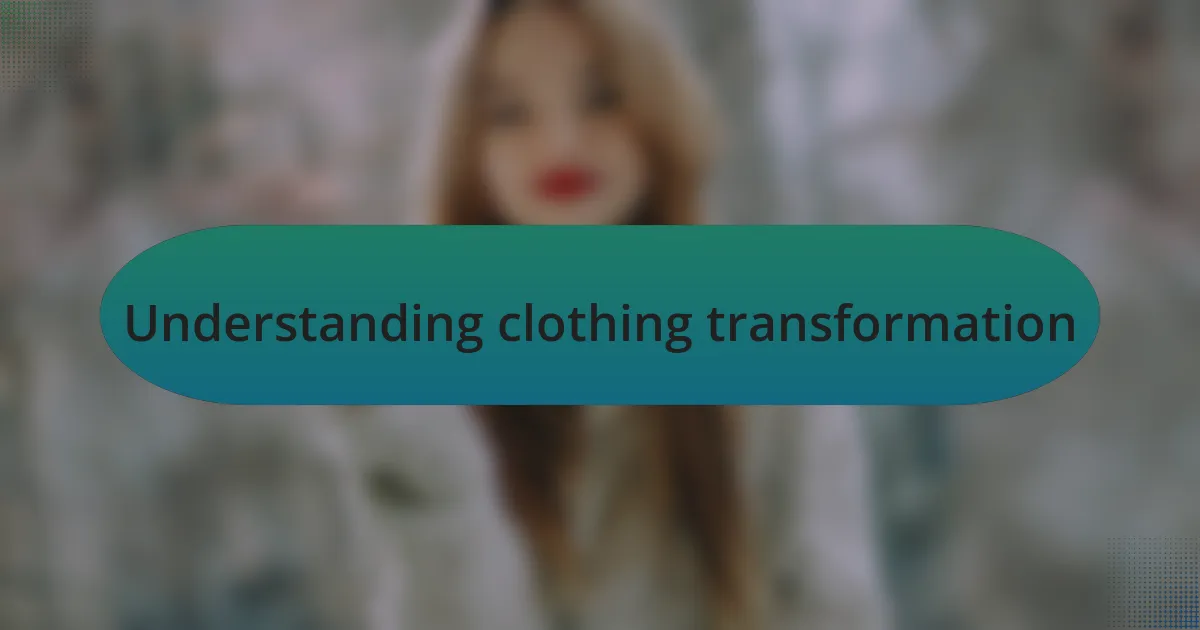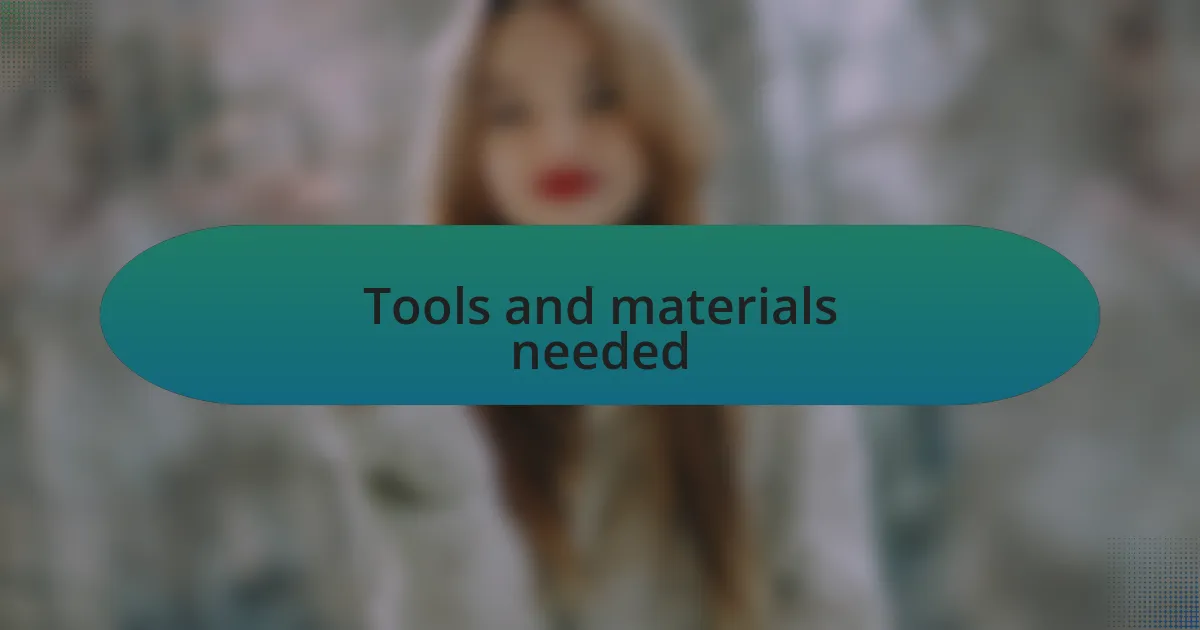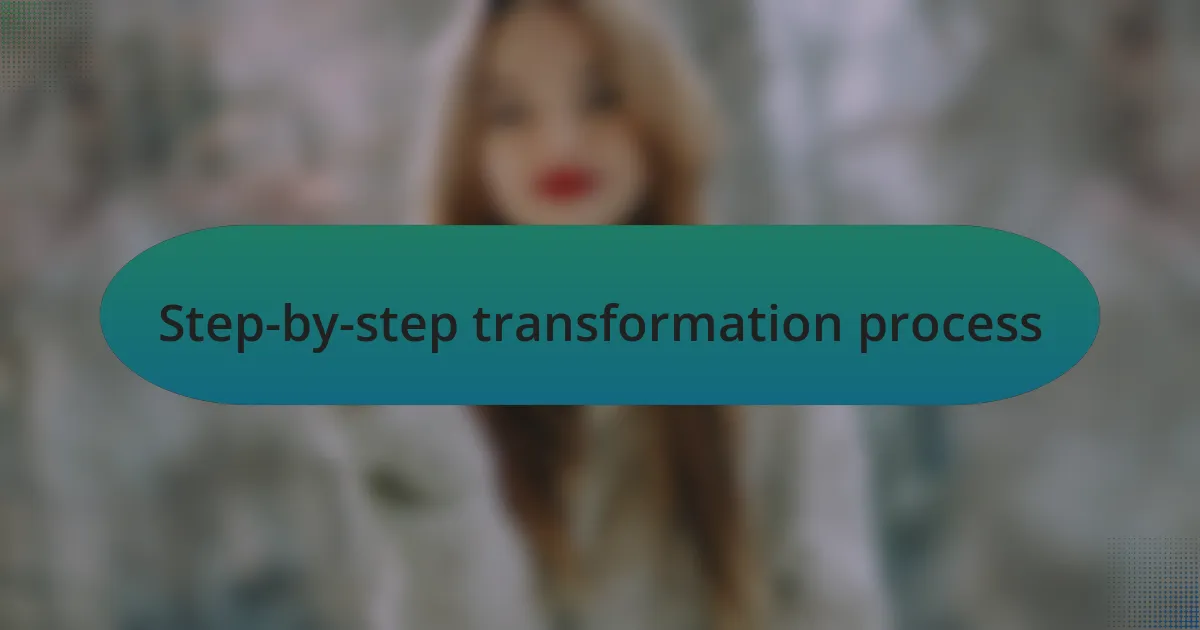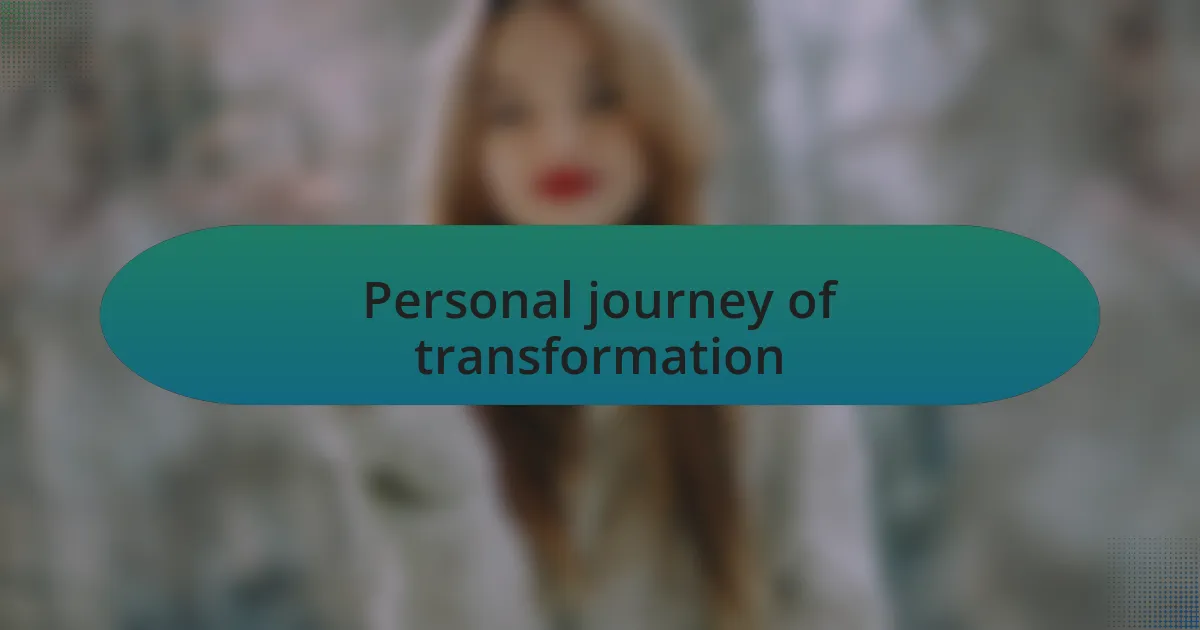Key takeaways:
- Clothing transformation is a blend of self-expression and sustainability, allowing individuals to create new narratives from old garments.
- Upcycling techniques, such as cutting, dyeing, and sewing patches, can revitalize worn clothing and promote eco-friendly fashion practices.
- The transformation process begins with visualization and careful deconstruction, ultimately leading to the creation of unique, personalized designs.
- Embracing experimentation with colors, textures, and materials enhances creativity and enables individuals to reflect their personality through fashion.

Understanding clothing transformation
Clothing transformation is more than just a trend; it’s a form of self-expression. I vividly remember taking an old oversized flannel shirt and turning it into a trendy crop top. The thrill of seeing something I once considered outdated transformed into a fashion statement was exhilarating.
When I think about transforming clothes, I often ponder: what stories do these garments hold? Each piece has a history, and by reimagining them, we create new narratives while honoring the past. This emotional connection drives me to explore various techniques, from simple alterations to elaborate upcycling projects, making each transformation feel like a fresh start.
There’s a unique satisfaction in breathing new life into something that has lost its relevance in our closet. I’ve witnessed firsthand how a little creativity and effort can make old clothes feel vibrant again, sparking both joy and pride in my ability to innovate. What do you think your clothes would say if they had the chance to be redefined?

Importance of sustainable fashion
Embracing sustainable fashion is crucial for our planet’s health. I recall a project where I transformed a worn-out dress into a chic skirt, not just to refresh my wardrobe, but to reduce waste. Each time I repurpose old garments, I become more aware of the significant environmental impact of fast fashion—pollution, textile waste, and resource depletion.
Sustainability in fashion also fuels creativity. I often find that the challenge of reimagining old clothes pushes me to think outside the box. Isn’t it fascinating how a simple alteration can create a unique piece that reflects personal style while being eco-friendly at the same time? This connection between innovation and sustainability resonates deeply with me.
Incorporating sustainable practices into our wardrobes fosters a sense of community responsibility. I’ve noticed that when I share my transformations with friends, it inspires them to consider their old clothes differently. What if we all took the time to see the potential in our unused pieces? This shift in perspective can lead to a more mindful approach to fashion that benefits both us and the planet.

Techniques for transforming old clothes
When it comes to transforming old clothes, I’ve found that upcycling is one of the most rewarding techniques. I remember taking a plain oversized shirt, cutting it down the middle, and adding a colorful fabric strip to give it a new shape and personality. It not only became a trendy open layer for my outfits but also a statement about my commitment to sustainable practices. Have you ever thought about how one simple cut can breathe new life into forgotten pieces?
Another fascinating technique is dyeing. I had a pair of faded jeans that I loved but looked too worn out to wear. Instead of tossing them, I soaked them in a rich indigo dye and ended up with an entirely new pair. The process was fun and surprisingly easy! Plus, it brings an opportunity to experiment with colors and patterns—what would you choose to revive in your wardrobe?
Sewing patches is yet another great method for upcycling clothes. I had a light jacket covered in small stains that I initially wrote off. By sewing on fabric patches I found at a local craft store, I turned it into a stylish, eclectic piece. There’s something so satisfying about not just covering imperfections but celebrating them. Have you ever turned a flaw into a feature? The transformation can make a garment feel even more unique and cherished.

Tools and materials needed
When preparing to transform old clothes, the right tools can make a significant difference. I always start with a good pair of sharp fabric scissors. They make cutting through layers effortless. Have you ever struggled with dull scissors? I have, and it’s incredibly frustrating! A rotary cutter can also be a game-changer for precise cuts, especially when I’m working on an intricate design.
Next up is my trusty sewing machine. I can’t emphasize enough how much it speeds up the process. The last time I transformed an oversized dress, I was amazed at how quickly I could stitch down hems and secure fabric patches. For those moments when a sewing machine isn’t practical, hand-sewing needles and thread are essential. Something about stitching by hand feels intimate, like a personal connection with the garment—you might feel the same if you’ve ever taken the time to mend something treasured.
Lastly, let’s talk about materials. Fabric paint, dye, and patches allow for endless creativity. I once used leftover fabric from a quilt project to create unique pockets on an old shirt, and it became a favorite. Have you considered what materials you might use? Old buttons, lace, or even beads can add that special touch, transforming the ordinary into the extraordinary.

Step-by-step transformation process
When it comes to the transformation process, the first step I take is to visualize the end product. I find that sketching out my ideas helps to clarify the design. Have you ever been caught up in a project without a clear vision? It can quickly become overwhelming. Trust me, spending those initial moments mapping out my thoughts has saved me countless hours of frustration.
Once I have a plan, I move on to carefully deconstructing the original piece. I remember transforming an old denim jacket, and the moment I started removing the sleeves, I felt a rush of excitement. It’s almost therapeutic to strip something down to its core, breathing new life into fabric that once felt stale. This stage is where you can experiment. Don’t hesitate to try new techniques—after all, this is your creative journey!
After deconstruction, it’s time for the fun part—assembling the new design! I lay out the pieces and start pinning them together. I vividly recall sewing the frayed edges of an old skirt into a trendy crop top; it was one of those “lightbulb moments” where everything just clicked. Every stitch brings a sense of accomplishment. I often think, “Why buy new when I can create?” This stage is about seeing potential in what you already have, and it can be incredibly rewarding.

Personal journey of transformation
As I reflect on my personal journey of transformation, I vividly recall the first piece I ever reimagined—a moth-eaten sweater that held sentimental value. Cutting into that fabric felt like releasing a piece of my past, and the nostalgia it stirred up was intense. Have you ever felt torn about altering something you love? That moment was a blend of apprehension and exhilaration, and it taught me that transformation often starts with letting go.
Over time, I began to view each piece of clothing as a canvas of memories waiting to be expressed. For instance, turning an oversized floral dress into a chic tote bag was not just a project; it was an emotional release. I remember stitching the last seam and feeling a sense of pride mixed with disbelief that I had transformed something I never wore into a cherished item. Isn’t it fascinating how clothes can evolve right alongside our emotions and experiences?
Now, I approach every transformation with a sense of adventure. Each garment carries its own story, and I see myself as a storyteller woven into every stitch. When I altered an old pair of jeans into a stylish pair of shorts, I felt more than just creativity; I felt empowered. Isn’t that what fashion is truly about—finding a reflection of ourselves in what we wear? This journey has reshaped not only my wardrobe but my entire outlook on personal style, embracing both change and self-expression.

Tips for unique designs
When it comes to creating unique designs, experimentation is key. I once took a simple white shirt and added vibrant patches from old band tees I hardly wore. The transformation breathed new life into that shirt, turning it from bland to vibrant. Can you imagine the stories those patches hold? Each stitch connected me to a different time in my life, making my new design not just a fashion statement, but a storytelling piece.
Another tip is to play with different textures. I remember taking an old denim jacket and layering it with lace and tulle from an unused dress. The combination created a striking contrast that turned heads whenever I wore it. Have you ever tried mixing fabrics? It can be daunting at first, but the unexpected pairings often yield the most stunning results—both visually and emotionally.
Don’t shy away from bold colors, either. I transformed a drab beige skirt into a colorful masterpiece by dyeing it with leftover fabric dye from previous projects. The vibrant colors reflected my mood and individuality; every time I wore it, I couldn’t help but smile. Have you ever felt uplifted by wearing something that perfectly matched your inner feelings? Choosing the right colors can be a powerful way to express your unique style, allowing your wardrobe to reflect who you truly are.